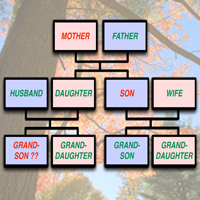Why are Some People Color Blind?
Genetics. We are all different in many ways due to genetics. Genetics is the study of how traits are inherited from our parents and earlier generations. For example, you might have red hair, blue eyes, or a hitch-hiker's thumb that you inherited from your parents. You might also notice that your brothers and sisters share certain traits with you that they inherited from your parents. Color blindness is one such trait. And just like we might be tall or short due to the genetic codes we inherited from our parents, we might end up with different sorts of color vision.
While not everything about color vision and color blindness is fully understood, the inheritance of color blindness is fairly well documented. Most types of color blindness are considered a sex-linked genetic trait. Genetic means that it is inherited (not acquired from the environment) and sex-linked means that the genes that encode color vision are on the same chromosomes that determine our gender. These genes are on the X-chromosome. Females have two X-chromosomes (one from the mother and one from the father) while males have just one X-chromosome (from the mother) and a Y-chromosome (from the father). Since much information on color vision resides on the X-chromosome, women have two opportunities to inherit full, normal color vision (they must inherit two faulty X-chromosomes in order to become color blind). Males, on the other hand, only have one X-chromosome and therefore only one chance to inherit normal color vision. If they inherit an X-chromosome from their mother that encodes deficient color vision, then that's what they have.
The above explains why color blindness is so rare in females (less than 0.5% of the population) and far more common in males (about 8% of the population). Women can carry the deficiency without expressing the trait, while men that are carrying the deficiency also have the trait. As we like to remind our teenage daughter, life is not fair!
What happens when one inherits a color vision deficiency is that they do not get all three types of cone photoreceptors. Instead they only get two types. Protanopia refers to a lack of red-sensitive cones, deuteranopia to a lack of green-sensitive cones, and tritanopia to a lack of blue-sensitive cones. There are also anomalous observers who have a variant of one of the cone types instead of the normal type. Lastly, there are some rare individuals who are monochromats and can only see in shades of gray.
![]()
Explore the NEXT TOPIC at this level.
Explore the NEXT LEVEL on this topic.
Ever wonder ... Why aren't my photographs the same colors as the original scenes?
Updated: Apr. 19, 2011

